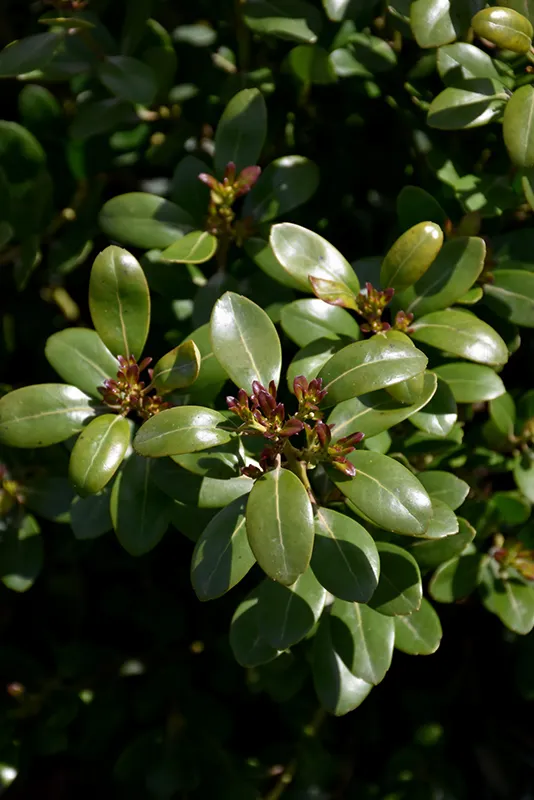Family: Holly
Type: Shrub

Shamrock Inkberry Holly, scientifically known as Ilex glabra ‘Shamrock’, is a dense, evergreen shrub. It is valued for its rich green foliage and compact, rounded form.
This variety is distinguished by its small, glossy leaves and a tendency to maintain a fuller, more uniform shape than other inkberries. It’s an excellent choice for creating a consistent, low-maintenance hedge or border.
Shamrock Inkberry Holly thrives in full sun to partial shade and is hardy in zones 5-9. It prefers acidic, well-draining soil and is tolerant of wet conditions, making it versatile for various landscape settings.
Hardiness Zone: 5a-4a
Pet Friendly: Yes
Moisture Preference: Moist to wet
Sun Needs: Full sun to partial shade
Growth Rate: Slow
Average Height (feet): 4
Average Spread (feet): 4
Average Life Span (years): 40
Form: Oval
Foliage Color: Green
Foliage Shape: Narrow
Bark Color: Gray
Bark Texture: Smooth
Incorporating Shamrock Inkberry Holly into your landscape design offers a lush, evergreen backdrop. Its dense foliage provides year-round interest and texture.
This shrub is perfect for creating formal hedges, foundation plantings, or as a natural screen. Its adaptability to pruning makes it suitable for topiary or more structured garden designs.
Despite its formal appearance, Shamrock Inkberry Holly is relatively low maintenance. It’s a great choice for gardeners who desire an attractive, easy-care shrub.

In formal gardens, Shamrock Inkberry Holly can be used to create neat, precise hedges or as a structured element in garden designs. Its uniform growth habit is ideal for symmetry.
For wetland or rain gardens, this shrub is an excellent choice. It tolerates wet conditions, making it suitable for areas with moist soil.
In woodland garden settings, Shamrock Inkberry Holly adds evergreen interest. Its tolerance for shade and natural form blend well with a woodland aesthetic.
Use it to form a low hedge along property lines or garden beds. Its dense growth provides a neat, clean look that borders and defines spaces.
Plant it in mass for a uniform, lush ground cover. Grouping several Shamrock Inkberries together creates an unbroken sea of green.
Combine it with flowering perennials or bulbs. Its deep green foliage provides a beautiful contrast and backdrop for colorful flowers.
Select our pre-made garden layouts to create a landscape that’s uniquely yours. Simple, smart, and customizable!
In spring, Shamrock Inkberry Holly begins to grow new leaves, enhancing its lush appearance in the garden.
During summer, the shrub maintains its deep green color. Its dense foliage provides a steady backdrop in the landscape.
In the fall, Shamrock Inkberry Holly continues to display its evergreen beauty. The plant remains unchanged, offering consistent structure in the garden.
In winter, Shamrock Inkberry Holly stands out with its evergreen leaves. Its resistance to winter burn makes it a valuable addition to the cold-season landscape.
Liatris spicata
Panicum virgatum 'Northwind'
Berberis Thunbergii 'Crimson Pygmy'
Shamrock Inkberry Holly is best planted in areas with full sun to partial shade. It’s ideal for damp areas in your yard, such as near water features or in low-lying spots that retain moisture.
This plant thrives in full sun to partial shade. While it can tolerate a range of light conditions, sufficient sunlight encourages denser foliage growth.
Shamrock Inkberry Holly prefers acidic, well-draining soil. It's particularly well-suited for wet conditions, making it a versatile choice for various landscape settings.
Space Shamrock Inkberry Holly plants about 3 to 4 feet apart. This spacing allows each plant enough room to grow while maintaining its dense, rounded form.
The best time to plant is in the spring or early fall. Cooler temperatures during these periods are ideal for root establishment.
Dig a hole as deep as the root ball and twice as wide. Place the plant in the hole, backfill with soil, and water thoroughly. Ensure the plant is level with the surrounding ground.
Regular watering is important, especially in dry conditions and during the first growing season. Once established, Shamrock Inkberry Holly is quite tolerant of wet conditions.
Fertilize in early spring with an acid-forming fertilizer to encourage vibrant growth and maintain soil acidity.
Minimal pruning is needed. If desired, prune in late winter or early spring to shape the plant or control its size.
In spring, apply a fresh layer of mulch and start regular watering and fertilizing as new growth appears.
Maintain moisture during summer, especially in dry periods. Monitor for pests and diseases, treating as necessary.
Reduce watering in the fall as the plant begins to go dormant. Prepare the plant for winter by cleaning up any fallen leaves.
Shamrock Inkberry Holly is hardy in winter. Ensure it's well-mulched to protect the roots in colder climates.
Ilex crenata 'Sky Pencil'
Ilex crenata Soft Touch
Ilex verticillata 'Red Sprite'
Shamrock Inkberry Holly typically reaches about 3-4 feet in height and width, forming a compact, rounded shape.
While no plant is completely deer-proof, Shamrock Inkberry Holly is relatively deer-resistant and less likely to be damaged compared to other shrubs.
Yes, Shamrock Inkberry Holly is excellent for hedges due to its dense growth and tolerance for pruning. It creates a neat, evergreen boundary.
Sign up below to get exclusive deals, discounts, and new plant collections—delivered straight to your inbox! Plus, stay inspired with the latest gardening tips, landscaping trends, and DIY garden ideas. Start growing with us today!
A big thank you for subscribing to the PBN Design newsletter.
We're thrilled to have you join our community. Get ready for exciting updates, insightful content, and more delivered straight to your inbox.
Stay tuned!
Go backA big thank you for subscribing to the PBN Design newsletter.
We're thrilled to have you join our community. Get ready for exciting updates, insightful content, and more delivered straight to your inbox.
Stay tuned!
Go back